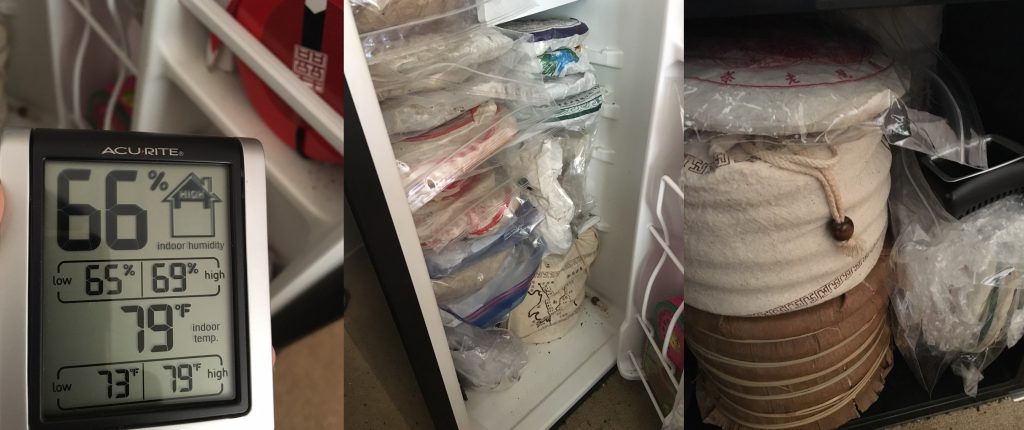I’ve been fortunate to meet and get connected with a variety of drinkers and pu’erh collectors throughout the years. One of these fine folks is Geraldo of Far Wenwa, who was a collaborator for the old tea blog Chadao. I recommend people check out his store if you want a taste of US stored tea (based a couple hours east of Seattle). He is in the first wave of western pu’erh drinkers, a nice guy, his prices aren’t bad and the storage is interesting. Geraldo bought the bulk of his tea back in the mid 2000s, when the pu’erh scene in the west was in its infancy. It was acquired partly through traveling, places like Taishunhe, some from Jing Tea Shop and some through a very young ebay store called Yunnan Sourcing.

One tea I had from Geraldo is the 2005 Dayi Menghai Peacock. This is one of the fancier products from what has become an increasingly expensive year for Dayi. A friend bought some back in 2016 and I ended up with a cake and some leftovers. At the time I dismissed it as needing more time and put it in my storage. It’s now hung out in my storage for about nearly a decade. The tea currently sells for a very high (dumb) price in China, so I decided to retry it, given it is now 20 years old, and stored almost exclusively in Washington state.. So how is it?? You can tell there’s high quality material here, but it still needs more time. It brews a faint orange and the green edge of younger sheng is still quite prominent. And most depressingly, the tea is 20 years ago. This is true not just for the Menghai Peacock but for a lot of the teas that have been exclusively western dry-stored. I tried a few teas with lesser pedigree (2004 6FM Youle/Yiwu) and the results are not anymore promising. This is not to insult Geraldo as a large chunk of the storage time was spent in my care!
I originally thought 20 years or so would be a good amount of time to age a tea to achieve a satisfactory level of aging. 20 years is a long time! It is also a long enough amount of time that you can trick yourself into waiting. Western dry storage on decent factory teas, even with humidity added, has only slowly moved it. Some people talk about teas eventually turning a corner. It hasn’t happened yet.. Perhaps in another 20 years? In unheated pumidor land we are most definitely not on the express train for aged tea.
You could argue that many of the classics needed more than 20 years of dry storage, but I think we’re talking about an entirely different beast (slow western storage vs. HK Dry).
There is Very Little Exclusively Western Stored Teas Aged to a Satisfying Amount
This is the sad state of (unheated) western storage. I’ve had teas that are moving in the right direction, but there’s very little that has been exclusively western stored that I’d consider to be a good aged tea. This is a bit unfair as there’s not many people that have stored tea for 20 years. I also don’t doubt someone like shah, based in the south, will have some decent enough aged tea given enough time. Still, the lack of track record 20 years after Geraldo and the early western pioneers bought pu’erh is concerning.

Ways Around The Long Term Aging Question (Buying Already Aged, 6FM, Hotbox)
I get around the aging dilemma by buying teas that are a lot more aged from a hotter and more humid climate than my own. Taiwan, Guangzhou, Hong Kong, Malaysia, etc.. This has more or less worked especially for certain types of teas that have the greener edge already taken off before purchase.. For instance, Yiwu and other 6 famous mountain productions are a category I’m alright drinking with around 10ish years of Taiwanese or Guangdong storage. After some time in Seattle, it’s not totally clear how much they’ve changed but I still like them and my storage has at least maintained them. Even something like the 2006 Chenguanghetang Yiwu Yecha stored in Houston and Seattle isn’t bad, although I’d probably like the tea more if it had a decade in Malaysia instead.
Less successfully, the factory (Dayi and Xiaguan) teas just need longer. Despite a generally favorable opinion of Dayi teas and following a similar buying strategy of purchasing semi-aged tea, there’s very few I’ve bought that I enjoy drinking. Not because the material is bad, they’re just too green and abrasive for my tastes and need more time. Most are moving in the right direction, but aren’t at an acceptable point to be easy enough to drink. Part of this is my preference for smoother, darker tea that not everyone shares. But a lot of it is simply that the good versions of these teas were not created for immediate drinking and certainly not for storage in western climates. Drinking them you can also tell they are not close to their potential yet. As a final caveat, it is possible 10 years from now many of them will have turned the curve and changed my own feelings on that topic..
Another potentially promising storage method would be Marco-style hotboxing. Heated storage has really caught on out west, especially amongst newer pu’erh enthusiasts. I’ve tasted the Bosch from Marco a few years back and it seemed promising. For myself, this sort of storage is unlikely for reasons mostly related to my personal life. I have too much tea that takes a good deal of space already (unlikely to change) and I doubt setting up another huge project will improve my WAF (Wife Acceptance Factor). Despite this, if I was a part of the new generation of drinkers without a huge quantity of cakes, it’s likely I would’ve been one of the hotboxers.
Final Note: If you’ve been hotboxing for a few years and want to donate a sample, I would be curious to try.


Leave a Reply